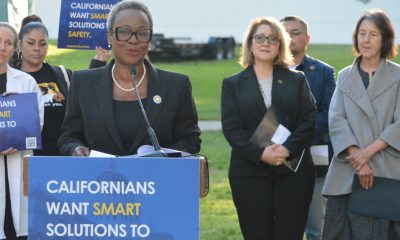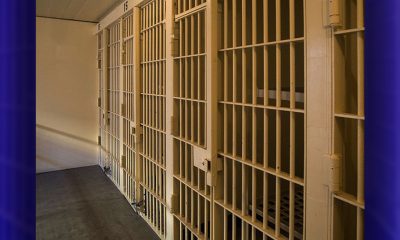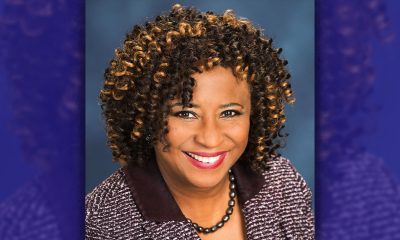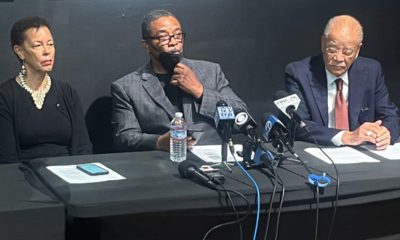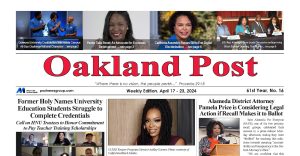Politics
One of the Angola Three Recalls Life in Solitary Confinement

This April 22, 2009, file photo, shows a view of the front entrance of the Louisiana State Penitentiary in Angola, La. Albert Woodfox, the last of three high-profile Louisiana prisoners known as the “Angola Three,” could walk free within days after a federal judge ordered state officials to release him immediately. Woodfox has been in solitary confinement for 43 years. He was accused, along with three other prisoners, in the stabbing death of Brent Miller, a 23-year-old guard at the Louisiana State Penitentiary at Angola. (AP file photo/Judi Bottoni, File)
STACEY PLAISANCE, Associated Press
REBECCA SANTANA, Associated Press
NEW ORLEANS (AP) — Robert King says he watched nearly three decades of his life fade away in solitary confinement inside Louisiana’s Angola prison, sometimes glimpsing the world through a small window and longing for the few hours a week he might feel the sun on his face.
“We were caged up,” said King, who was released in 2001 after a court reversed his conviction in the death of a fellow inmate in 1973. “I don’t think a person can go through that and come up unscathed.”
King is one of three men known as the “Angola Three,” who supporters say spent decades in solitary confinement at the Louisiana State Penitentiary, often referred to simply as Angola, the town in which it’s located.
Another man, Herman Wallace, was released in October 2013 when a judge granted him a new trial and died days later.
Now, King is closely watching the fate of the last of the three, Albert Woodfox, after a judge this week ordered his immediate release and barred the state from trying him a third time in the killing of a prison guard in 1972.
The attorney general is fighting that ruling and won an emergency stay keeping him in jail while the two sides argue the matter before an appeals court.
In court filings Wednesday, Woodfox’s lawyers argued that he does not pose a flight risk if released, needs medical attention and would submit to electronic surveillance if released.
The lawyers also argued that prosecutors’ claims that Woodfox was dangerous were “starkly untrue.”
State officials have said repeatedly that the evidence shows he is a killer. They say Woodfox has been in a form of protective custody called closed cell restriction, but not solitary confinement. They say he’s allowed to watch television through the bars of his cell, talk to other inmates in his tier, read books, talk to visiting chaplains and leave his cell every day for an hour.
“The perception of ‘solitary confinement’ is a far cry from the reality,” said Aaron Sadler, a spokesman for the Attorney General’s office.
For now, Woodfox is being held in a jail where he’s awaited his new trial since February. His supporters estimate he’s spent a total of more than four decades in isolation, with some breaks in the 1990s and in 2008.
It’s a situation King knows well. He spoke to The Associated Press by telephone from Austin, Texas, where he now lives.
King said he was shackled at the hands and feet anytime he left his cell. He said he could see and converse with a handful of other inmates in the immediate vicinity, but they all had to be careful not to talk too loud, or too much, or they would be written up.
The conditions changed over time. At first there was no window or time outside, but eventually he was allowed outside for short periods a few times a week and given a cell with a window.
“If it was raining, too hot, too cold, they wouldn’t let us go outside, and they wouldn’t give us makeup time,” he said.
Many experts say such conditions, whatever the name, can have detrimental effects on inmates. Some have reported anxiety, paranoia, depression and hallucinations, said Dr. Sharon Shalev, a research associate from the Centre for Criminology at the University of Oxford who runs the website www.solitaryconfinement.org.
Shalev said she’s had prisoners tell her they harmed themselves just to reaffirm they were still alive.
There are no precise figures on the number of inmates held in isolation, the Vera Institute of Justice said in a May report. However, the report said estimates range from 25,000 — which includes only those held in so-called supermax facilities — to 80,000, which includes those held in some type of segregated housing across all state and federal prisons.
The report also said inmates in isolation are more likely to kill or hurt themselves than those held in the general population.
What has made the case of the Angola Three and Woodfox in particular such a lightning rod for international attention has been the length of time they were in isolation. Tory Pegram of the International Coalition to Free the Angola 3 said Woodfox was first put in solitary in April 1972, the same day the guard he was eventually accused of killing died.
Louisiana corrections officials have said he was in closed cell restriction for many years but declined to elaborate because litigation is pending.
Meanwhile, King is eagerly awaiting his friend’s release. He started driving from his home in Austin on Tuesday to meet Woodfox when he was released but turned around when that release was delayed. But he plans to be there if and when Woodfox walks out of the jail.
In the years since his release, King has written a book and often gives talks on his experiences. When asked how he didn’t go crazy, he replied, laughing, “I didn’t say I wasn’t crazy.”
“It was bitter,” he said. “But there are some things that you can make out of lemons. I just tried every day to make lemonade.”
___
Follow Santana on Twitter: @ruskygal. Follow Plaisance: @splaisance
Copyright 2015 The Associated Press. All rights reserved. This material may not be published, broadcast, rewritten or redistributed.
Bay Area
MAYOR BREED ANNOUNCES $53 MILLION FEDERAL GRANT FOR SAN FRANCISCO’S HOMELESS PROGRAMS
San Francisco, CA – Mayor London N. Breed today announced that the U.S. Department of Housing and Urban Development (HUD) has awarded the city a $53.7 million grant to support efforts to renew and expand critical services and housing for people experiencing homelessness in San Francisco.

FOR IMMEDIATE RELEASE:
Wednesday, January 31, 2024
Contact: Mayor’s Office of Communications, mayorspressoffice@sfgov.org
***PRESS RELEASE***
MAYOR BREED ANNOUNCES $53 MILLION FEDERAL GRANT FOR SAN FRANCISCO’S HOMELESS PROGRAMS
HUD’s Continuum of Care grant will support the City’s range of critical services and programs, including permanent supportive housing, rapid re-housing, and improved access to housing for survivors of domestic violence
San Francisco, CA – Mayor London N. Breed today announced that the U.S. Department of Housing and Urban Development (HUD) has awarded the city a $53.7 million grant to support efforts to renew and expand critical services and housing for people experiencing homelessness in San Francisco.
HUD’s Continuum of Care (CoC) program is designed to support local programs with the goal of ending homelessness for individuals, families, and Transitional Age Youth.
This funding supports the city’s ongoing efforts that have helped more than 15,000 people exit homelessness since 2018 through City programs including direct housing placements and relocation assistance. During that time San Francisco has also increased housing slots by 50%. San Francisco has the most permanent supportive housing of any county in the Bay Area, and the second most slots per capita than any city in the country.
“In San Francisco, we have worked aggressively to increase housing, shelter, and services for people experiencing homelessness, and we are building on these efforts every day,” said Mayor London Breed. “Every day our encampment outreach workers are going out to bring people indoors and our City workers are connecting people to housing and shelter. This support from the federal government is critical and will allow us to serve people in need and address encampments in our neighborhoods.”
The funding towards supporting the renewal projects in San Francisco include financial support for a mix of permanent supportive housing, rapid re-housing, and transitional housing projects. In addition, the CoC award will support Coordinated Entry projects to centralize the City’s various efforts to address homelessness. This includes $2.1 million in funding for the Coordinated Entry system to improve access to housing for youth and survivors of domestic violence.
“This is a good day for San Francisco,” said Shireen McSpadden, executive director of the Department of Homelessness and Supportive Housing. “HUD’s Continuum of Care funding provides vital resources to a diversity of programs and projects that have helped people to stabilize in our community. This funding is a testament to our work and the work of our nonprofit partners.”
The 2024 Continuum of Care Renewal Awards Include:
- $42.2 million for 29 renewal PSH projects that serve chronically homeless, veterans, and youth
- $318,000 for one new PSH project, which will provide 98 affordable homes for low-income seniors in the Richmond District
- $445,00 for one Transitional Housing (TH) project serving youth
- $6.4 million dedicated to four Rapid Rehousing (RRH) projects that serve families, youth, and survivors of domestic violence
- $750,00 for two Homeless Management Information System (HMIS) projects
- $2.1 million for three Coordinated Entry projects that serve families, youth, chronically homeless, and survivors of domestic violence
In addition, the 2023 CoC Planning Grant, now increased to $1,500,000 from $1,250,000, was also approved. Planning grants are submitted non-competitively and may be used to carry out the duties of operating a CoC, such as system evaluation and planning, monitoring, project and system performance improvement, providing trainings, partner collaborations, and conducting the PIT Count.
“We are very appreciative of HUD’s support in fulfilling our funding request for these critically important projects for San Francisco that help so many people trying to exit homelessness,” said Del Seymour, co-chair of the Local Homeless Coordinating Board. “This funding will make a real difference to people seeking services and support in their journey out of homelessness.”
In comparison to last year’s competition, this represents a $770,000 increase in funding, due to a new PSH project that was funded, an increase in some unit type Fair Market Rents (FMRs) and the larger CoC Planning Grant. In a year where more projects had to compete nationally against other communities, this represents a significant increase.
Nationally, HUD awarded nearly $3.16 billion for over 7,000 local homeless housing and service programs including new projects and renewals across the United States.
Activism
Oakland Post: Week of April 17 – 23, 2024
The printed Weekly Edition of the Oakland Post: Week of April 17 – 23, 2024

To enlarge your view of this issue, use the slider, magnifying glass icon or full page icon in the lower right corner of the browser window. ![]()
Barbara Lee
Congresswoman Barbara Lee Issues Statement on Deaths of Humanitarian Aid Volunteers in Gaza
On April 2, a day after an Israeli airstrike erroneously killed seven employees of World Central Kitchen (WCK), a humanitarian organization delivering aid in the Gaza Strip, a statement was release by Rep. Barbara Lee (D-CA-12). “This is a devastating and avoidable tragedy. My prayers go to the families and loved ones of the selfless members of the World Central Kitchen team whose lives were lost,” said Lee.

By California Black Media
On April 2, a day after an Israeli airstrike erroneously killed seven employees of World Central Kitchen (WCK), a humanitarian organization delivering aid in the Gaza Strip, a statement was release by Rep. Barbara Lee (D-CA-12).
“This is a devastating and avoidable tragedy. My prayers go to the families and loved ones of the selfless members of the World Central Kitchen team whose lives were lost,” said Lee.
The same day, it was confirmed by the organization that the humanitarian aid volunteers were killed in a strike carried out by Israel Defense Forces (IDF). Prior to the incident, members of the team had been travelling in two armored vehicles marked with the WCF logo and they had been coordinating their movements with the IDF. The group had successfully delivered 10 tons of humanitarian food in a deconflicted zone when its convoy was struck.
“This is not only an attack against WCK. This is an attack on humanitarian organizations showing up in the direst situations where food is being used as a weapon of war. This is unforgivable,” said Erin Gore, chief executive officer of World Central Kitchen.
The seven victims included a U.S. citizen as well as others from Australia, Poland, the United Kingdom, Canada, and Palestine.
Lee has been a vocal advocate for a ceasefire in Gaza and has supported actions by President Joe Biden to airdrop humanitarian aid in the area.
“Far too many civilians have lost their lives as a result of Benjamin Netanyahu’s reprehensible military offensive. The U.S. must join with our allies and demand an immediate, permanent ceasefire – it’s long overdue,” Lee said.
-

 Activism4 weeks ago
Activism4 weeks agoOakland Post: Week of March 27 – April 2, 2024
-

 #NNPA BlackPress4 weeks ago
#NNPA BlackPress4 weeks agoCOMMENTARY: D.C. Crime Bill Fails to Address Root Causes of Violence and Incarceration
-

 #NNPA BlackPress4 weeks ago
#NNPA BlackPress4 weeks agoFrom Raids to Revelations: The Dark Turn in Sean ‘Diddy’ Combs’ Saga
-

 #NNPA BlackPress4 weeks ago
#NNPA BlackPress4 weeks agoCOMMENTARY: Lady Day and The Lights!
-

 #NNPA BlackPress4 weeks ago
#NNPA BlackPress4 weeks agoMayor, City Council President React to May 31 Closing of Birmingham-Southern College
-

 #NNPA BlackPress4 weeks ago
#NNPA BlackPress4 weeks agoBaltimore Key Bridge Catastrophe: A City’s Heartbreak and a Nation’s Alarm
-

 #NNPA BlackPress4 weeks ago
#NNPA BlackPress4 weeks agoBaltimore’s Key Bridge Struck by Ship, Collapses into Water
-

 #NNPA BlackPress4 weeks ago
#NNPA BlackPress4 weeks agoBeloved Actor and Activist Louis Cameron Gossett Jr. Dies at 87


